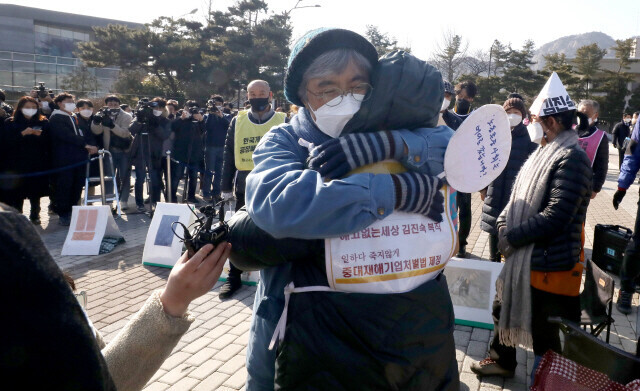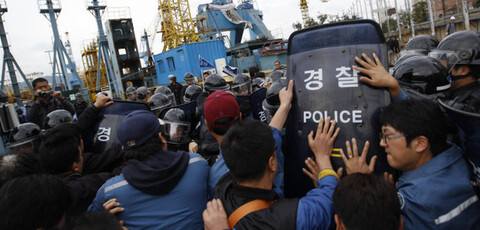hankyoreh
Links to other country sites 다른 나라 사이트 링크
Kim Jin-suk, trade unionist who scaled crane to protest layoffs, reinstated after 37-year struggle

“I can finally say out loud the words I shouted in my mind over a thousand times: ‘I’ve been reinstated!’”
This is just some of what Kim Jin-suk, a trade union activist who captivated the nation with her sit-in atop a crane in 2011, posted on Twitter Wednesday afternoon, right it was confirmed that she would be reinstated to her job.
Thirty-seven years after being sacked for her union activity, Kim, a former welder at a Busan shipyard run by the Korea Shipbuilding Corporation, will be reinstated on Friday, following an agreement between the Korean Metal Workers’ Union (KMWU) and HJ Shipbuilding & Construction for Kim’s honorary reinstatement and retirement.
Based on the agreement, Kim, who now serves as a direction committee member of the Busan headquarters of the Korean Confederation of Trade Unions (KCTU), will be reinstated to and retire from her position on Friday. Other details of her retirement will be decided based on negotiations between labor and management.
The government-operated Korea Shipbuilding Corporation was taken over by the Hanjin Group in 1989 and renamed Hanjin Heavy Industries & Construction (HHIC), which was then acquired by Dongbu Corporation Consortium in 2021 and renamed HJ Shipbuilding & Construction.
Kim joined the Korea Shipbuilding Corporation’s Youngdo shipyard in Busan as a welder in 1981, when she was 21 years old. In February 1986, she was elected as a representative of her labor union, after which she distributed leaflets exposing corruption in the union’s executive board, for which she was hauled away and interrogated by the police. Five months later, in July 1986, Kim was fired from her post at the shipyard.
During a phone call with the Hankyoreh, Kim said, “My comrades who fought with me and passed away are who I am thinking of the most, and I also feel sorry towards them [. . .] They were all probably waiting for this moment.”
She continued, “Those who joined the Hope Bus movement, those who walked all the way to the Blue House in protest, those in the HHIC branch within the KMWU — their joined forces brought about the outcome of reinstatement.”
Even after being dismissed, Kim continued to work with Korean laborers in general and laborers at the Youngdo shipyard in particular.
When Kim Ju-ik, head of the HHIC labor union, and Kwak Jae-kyu, a fellow union member, took their lives in 2003 in protest of management’s demand for compensation and provisional seizures in response to the union going on strike, and when Hanjin Heavy laid off labors in 2011, Kim was on the frontlines of the struggle.
Particularly, her 309-day occupation of Crane No. 85 at Youngdo shipyard in 2011 led to the nationwide Hope Bus movement, which marked the beginning of a new kind of labor activism in Korea.
Outside of the shipyard, Kim also stood alongside laborers unduly dismissed from companies such as SsangYong Motor Company, the Korea Rail Road Corporation, and Yeungnam University Medical Center. She acted as a spokesperson for laborers and touched the hearts of many not just through public addresses at labor protests but also through Twitter, which she started using during her crane-top protest.

Despite all her efforts, Kim wasn’t able to return to work herself. The 2003 struggle led by Kim Ju-ik and Kwak Jae-kyu brought about the reinstatement of 20 HHIC laborers, but Kim’s name wasn’t on the list. Even more, in 2009, a governmental committee tasked with deliberating on the rehabilitation and compensation for individuals involved in Korea’s democratization movement acknowledged Kim’s 1986 struggle to democratize her labor union as a pro-democracy movement and recognized her dismissal as unfair, recommending HHIC to reinstate her. HHIC did not take the recommendation.
As she neared the retirement age of 60, Kim began her struggle for reinstatement in earnest in 2020. The KMWU’s HHIC branch set up a tent sit-in on the company’s premises, and union members began a hunger strike in solidarity. The committee for compensation of individuals involved in pro-democracy struggles reiterated its recommendation for Kim’s reinstatement to HHIC in September 2020, and the National Assembly’s Environment and Labor Committee and Busan’s city council also urged HHIC to reinstate Kim.
On Dec. 30, 2020, the day before Kim turned 60, civic groups and other unduly dismissed laborers set off on a march from Busan to the Blue House, calling for Kim’s reinstatement.
Nevertheless, HHIC refused to reinstate Kim, arguing that doing so would constitute malpractice. Signs of a change emerged only after the Dongbu Construction Consortium took over HHIC last September, and the company turned over a new leaf as HJ Shipbuilding & Construction (HJSC).
Discussions regarding the reinstatement of Kim accelerated starting Jan. 20, finally culminating in an agreement.
Regarding the matter, an official with HJSC said, “Regardless of legal qualifications, we regret that a laborer and a colleague who worked with us in the past had to suffer through the pains of the times, and we decided to open up a path to honorary reinstatement and retirement for humanitarian purposes.”
Kim’s reinstatement and retirement ceremony will be held on Friday. Though the specifics of the event have not been finalized, Kim plans to dine with union members at the employee cafeteria and look around the workplace she and her fallen comrades Park Chang-su, Kim Ju-ik, Kwak Jae-kyu and Choi Kang-seo labored in, as she always hoped to do in the event of her reinstatement.
Kim told the Hankyoreh, “I was able to realize my dream after 37 years thanks to union members and the fact that the shipyard [where I worked] still exists, but laborers of the Cheonggye Clothing, Dong Il Textile, and YH unions who fought the hard fight during the dictatorships of the ‘70s and ‘80s have no workplace to return to.”
She added, “In Busan, laborers who worked at Samhwa Rubber and other shoe factories still live with the stigma of having been dismissed. At the minimum, I hope a path towards honorary reinstatement is opened through special legislation for laborers who received recommendations for reinstatement from the committee for the deliberation of compensation for the pro-democracy movement.”
By Park Tae-woo, staff reporter
Please direct questions or comments to [english@hani.co.kr]

Editorial・opinion
![[Column] Has Korea, too, crossed the Rubicon on China? [Column] Has Korea, too, crossed the Rubicon on China?](https://flexible.img.hani.co.kr/flexible/normal/500/300/imgdb/original/2024/0419/9317135153409185.jpg) [Column] Has Korea, too, crossed the Rubicon on China?
[Column] Has Korea, too, crossed the Rubicon on China?![[Correspondent’s column] In Japan’s alliance with US, echoes of its past alliances with UK [Correspondent’s column] In Japan’s alliance with US, echoes of its past alliances with UK](https://flexible.img.hani.co.kr/flexible/normal/500/300/imgdb/original/2024/0419/2317135166563519.jpg) [Correspondent’s column] In Japan’s alliance with US, echoes of its past alliances with UK
[Correspondent’s column] In Japan’s alliance with US, echoes of its past alliances with UK- [Editorial] Does Yoon think the Korean public is wrong?
- [Editorial] As it bolsters its alliance with US, Japan must be accountable for past
- [Guest essay] Amending the Constitution is Yoon’s key to leaving office in public’s good graces
- [Editorial] 10 years on, lessons of Sewol tragedy must never be forgotten
- [Column] A death blow to Korea’s prosecutor politics
- [Correspondent’s column] The US and the end of Japanese pacifism
- [Guest essay] How Korea turned its trainee doctors into monsters
- [Guest essay] As someone who helped forge Seoul-Moscow ties, their status today troubles me
Most viewed articles
- 1[Column] The clock is ticking for Korea’s first lady
- 2Samsung barricades office as unionized workers strike for better conditions
- 3[Editorial] When the choice is kids or career, Korea will never overcome birth rate woes
- 4[News analysis] After elections, prosecutorial reform will likely make legislative agenda
- 5S. Korea, Japan reaffirm commitment to strengthening trilateral ties with US
- 6All eyes on Xiaomi after it pulls off EV that Apple couldn’t
- 7After 2 months of delayed, denied medical care, Koreans worry worst may be yet to come
- 8US overtakes China as Korea’s top export market, prompting trade sanction jitters
- 9[Column] Has Korea, too, crossed the Rubicon on China?
- 10Hong Se-hwa, voice for tolerance whose memoir of exile touched a chord, dies at 76